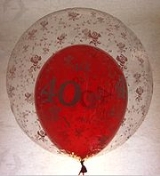
Ballonet
Encyclopedia

Aerostat
An aerostat is a craft that remains aloft primarily through the use of buoyant lighter than air gases, which impart lift to a vehicle with nearly the same overall density as air. Aerostats include free balloons, airships, and moored balloons...
of a non-rigid
Non-rigid airship
A blimp, or non-rigid airship, is a floating airship without an internal supporting framework or keel. A non-rigid airship differs from a semi-rigid airship and a rigid airship in that it does not have any rigid structure, neither a complete framework nor a partial keel, to help the airbag...
or semi-rigid
Semi-rigid airship
Semi-rigid airships are airships with a partial framework. These often consist of a rigid, or occasionally, flexible, keel frame along the long axis under the aerodynamic hull envelope. The partial framework can also be located inside the hull...
airship
Airship
An airship or dirigible is a type of aerostat or "lighter-than-air aircraft" that can be steered and propelled through the air using rudders and propellers or other thrust mechanisms...
. Such an airship can have one or more ballonets, commonly one fore
Bow (ship)
The bow is a nautical term that refers to the forward part of the hull of a ship or boat, the point that is most forward when the vessel is underway. Both of the adjectives fore and forward mean towards the bow...
and one aft
Stern
The stern is the rear or aft-most part of a ship or boat, technically defined as the area built up over the sternpost, extending upwards from the counter rail to the taffrail. The stern lies opposite of the bow, the foremost part of a ship. Originally, the term only referred to the aft port section...
. Because air is heavier than the lifting gas (usually helium
Helium
Helium is the chemical element with atomic number 2 and an atomic weight of 4.002602, which is represented by the symbol He. It is a colorless, odorless, tasteless, non-toxic, inert, monatomic gas that heads the noble gas group in the periodic table...
but, in the early days of lighter-than-air transport, hydrogen
Hydrogen
Hydrogen is the chemical element with atomic number 1. It is represented by the symbol H. With an average atomic weight of , hydrogen is the lightest and most abundant chemical element, constituting roughly 75% of the Universe's chemical elemental mass. Stars in the main sequence are mainly...
), the ballonets are deflated or inflated with air to maintain the external shape of the airship during ascent or descent. They can also be used to control the pitch of the airship.
The lower image illustrates the principle of a balloon within a balloon. The outer balloon represents the airship's outer envelope or gasbag; the red inner balloon represents the ballonet. In an airship the ballonet would be much smaller relative to the size of the gasbag, e.g. in the French airship Lebaudy Patrie
Lebaudy Patrie
The Lebaudy Patrie was a semi-rigid airship built for the French army in Moisson, France, by sugar manufacturers Lebaudy Frères. Designed by Henri Julliot, the company's chief engineer, the Patrie was completed in November 1906 and handed over to the military the following month, thus becoming the...
the ballonet's volume was approximately one-fifth that of the envelope.
The ballonet valves were originally a butterfly type, actuated by a spring system. The principle of actuation being that as the pressure rises in the ballonet, the spindle of the butterfly valve is compelled to turn under the increasing spring force, so relieving the pressure.
More recently actuation of the valve is done electrically with either a linear actuator (driven open/closed) or a linear solenoid (spring return), the latter being the favoured fail-to-safe arrangement.

